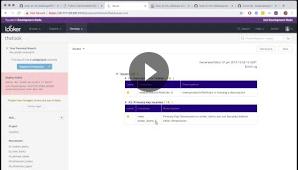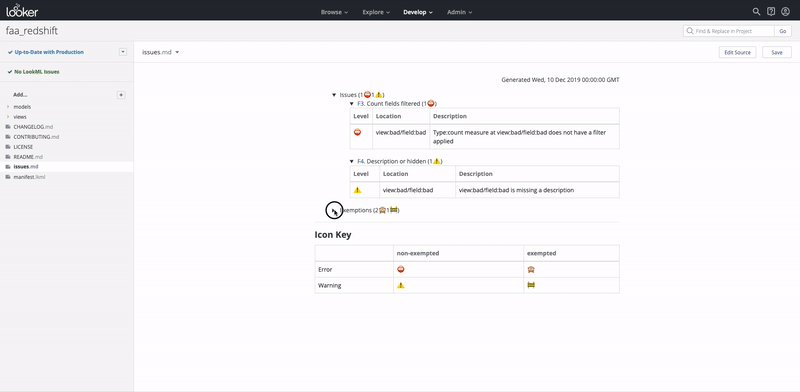LAMS is a style guide and linter for Looker's LookML data modeling language. It is designed to help a team of developers to produce more maintainable LookML projects.
- The style guide alone can help your project, even without enforcement by the linter.
- The linter comes with a number of built-in rules from the style guide.
- The linter also allows you to conveniently specify custom rules to enforce.
- The linter can be deployed to enforce rules for all commits to your master branch.
Interested? See a video of LAMS in action!
The linter comes with built-in rules that can enforce some rules from the style guide.
As of LAMS v3, you must opt-in via your manifest to use the built-in rules. Since the rules are opinionated, you likely want to pick and choose the ones that make sense for you. Here is an example declaration opting in to all the currently available built-in rules:
#LAMS
#rule: K1{} # Primary key naming
#rule: K3{} # Primary keys first
#rule: K4{} # Primary keys hidden
#rule: K7{} # Provide one `primary_key`
#rule: K8{} # `primary_key` uses PK dims
#rule: F1{} # No cross-view fields
#rule: F2{} # No view-labeled fields
#rule: F3{} # Count fields filtered
#rule: F4{} # Description or hidden
#rule: E1{} # Join with subst'n operator
#rule: E2{} # Join on PK for "one" joins
#rule: E6{} # FK joins are m:1
#rule: E7{} # Explore label 25-char max
#rule: T1{} # Triggers use datagroups
#rule: T2{} # Primary keys in DT
#rule: H1{} # Hoist identifiers
#rule: H2{} # Group fields
#rule: H3{} # Sort-group groups
#rule: H4{} # Group more
#rule: H5{} # Hoist main view
#rule: H6{} # Sort-group views
#rule: W1{} # Block indentationIn addition to linting against its style guide, LAMS also lets you specify your own rules. See Customizing LAMS.
You can opt-out of rules granularly by locally specifying rule exemptions.
The rule exemption syntax encourages developers (optionally) to document the reason for each such exemption:
view: rollup {
sql_table_name: my_table ;;
#LAMS exempt: K3 {why: "Bob said it's ok"}
dimension: info {...}
...(BETA) You can also opt-out of rules granularly from a centrally maintained lams-exemptions.ndjson file. Simply specify the rule name and location to exempt in a series of newline-terminated JSON objects:
{"rule":"K3","location":"model:my_model/view:rollup"}
{"rule":"K3","location":"model:my_other_model/view:foo"}Once LAMS has evaluated your project against the necessary rules, the resulting list of messages are communicated back to you through one of several output modes.
The default mode is a human-readable tabble logged to the command line / stdout, where each line represents a distinct message:
Another available output mode is formatting the messages into a markdown file in your project, so that they can be viewed in Looker's IDE. Here is an example of a resulting markdown file as displayed in Looker:
Although LAMS can be deployed in many ways to fit your specific CI flow, we have put together a few examples and resources to get you up and running quicker. (If you'd like to contribute your configuration, get in touch!)
Regardless of which example you follow, we recommend pinning your LAMS version to a particular major version.
- Local Interactive Usage - To use LAMS with the least overhead for simple interactive local use and testing:
npm install -g @looker/look-at-me-sideways@3
cd <your-lookml-project>
lams- Github Action - This option is commonly used among LAMS users, and has an up-to-date and convenient deployment example.
The remaining examples were prepared for v1 of LAMS, though updating them for v2+ should be straightforward. Please review v2 release notes for details. In particular, look for error messages on the console's standard output rather than a file output to be committed back to the repo.
- GitLab CI - A community-contributed configuration for GitLab, which offers similarly low overhead as our dockerized Jenkins configuration
- Dockerized Jenkins Server - We have provided a Docker image with an end-to-end configuration including a Jenkins server, LAMS, and Github protected branches & status checks configuration.
- CircleCI - A community-contributed configuration for CircleCI (external link)
-
reporting - Required. One of
yes,no,save-yes, orsave-no. See PRIVACY.md for details. - report-user - An email address to use in reporting. See PRIVACY.md for details.
- report-license-key - A Looker license key to use in reporting. See PRIVACY.md for details.
-
output - A comma-separated string of output modes from among:
lines(default),markdown,markdown-developer,jenkins,legacy-cli, or (BETA)add-exemptions -
source - A glob specifying which files to read. Defaults to
**/{*.model,*.explore,*.view,manifest}.lkml. - cwd - A path for LAMS to use as its current working directory. Useful if you are not invoking lams from your LookML repo directory.
- project-name - An optional name for the project, used to generate links back to the project in mardown output. Specifying this in manifest.lkml is preferred.
-
manifest-defaults - A file path or JSON-encoded object of default manifest values which may be overriden by the project manifest. The target file may be a lkml file, JSON file, or a YAML file if the
js-yamloptional peer dependency is installed. -
manifest - A file path or JSON-encoded object of manifest values that override values set by the project manifest. The target file may be a lkml file, JSON file, or a YAML file if the
js-yamloptional peer dependency is installed. -
on-parser-error - Set to "info" to indicate that LookML parsing errors should not fail the linter, but yield an
infolevel message instead (not all output modes displayinfolevel messages) -
verbose - Set to also output
verboselevel messages, for output modes that support it (lines) -
date-output - Set to "none" to skip printing the date at the top of the
issues.mdfile. - allow-custom-rules - Experimental and not recommended. Used to approve the running of Javascript-based custom rules. DO NOT USE TO RUN UNTRUSTED CODE. See custom rules for details.
More complex configurations, such as custom rule definitions, are provided in a manifest file. These may be provided either directly in your project's native manifest.lkml file using #LAMS conditional comments, or in a separate file specified by the manifest parameter.
If you have a small number of declarations, the native manifest.lkml file is a convenient place to add them.
If you are managing many declarations, you may want to consider installing js-yaml to maintain manifest configurations in a separate YAML file, to benefit from improved legibility and syntax highlighting. In this case, provide the path to the file in the manifest command-line argument.
In case both files are provided, declarations from both sources will be used, with the latter taking precedence. Similarly, the manifest-defaults command-line argument can be used to provide declarations with a lower priority than the native manifest.lkml.
The manifest can provide the following declarations:
- name - Recommended. A name for the project, used to generate links back to the project in mardown output. If the native LookML validator complains about an unnecessary project name, you can use a conditional #LAMS comment to specify it.
- rule: rule_name - Recommended. Used to opt-in to built-in rules and to specify custom rules. See customizing LAMS
- rule_exemptions - Optional. Originally used in v1 & v2 to opt-out of rules globally. A global opt-out can still be useful for opting-out of certain "sub rules" that a rule may return without opting-out of the entire rule.
-
js-yamlis not automatically installed with LAMS, but you may explicitly install it:- if you want to maintain your manifest configuration in YAML
- if you want to write custom rules that lint against the contents of a LookML Dashboard, which is a YAML-based file. In this case, also make sure to pass a
sourceargument, as the defaultsourcedoes not includes.dashboard.lookmlfiles.
LAMS respects user privacy. See PRIVACY.md for details.
LAMS is Copyright (c) 2023 Looker Data Sciences, Inc. and is licensed under the MIT License. See LICENSE.txt for license details.
LAMS is NOT officially supported by Looker. Please do not contact Looker support for issues with LAMS. Issues may be reported via the Issues tracker, but no SLA or warranty exists that they will be resolved.
LAMS has primarily been developed by Joseph Axisa and Fabio Beltramini. See all contributors
Bug reports and pull requests are welcome on GitHub at https://github.com/looker-open-source/look-at-me-sideways.
Trying to install LAMS for development?
git clone git@github.com:looker-open-source/look-at-me-sideways.git
cd look-at-me-sideways
mv npm-shrinkwrap.dev.json npm-shrinkwrap.json
npm installPublishing an update? The following hooks will run:
npm version {minor|major|patch}
> Pre-verion: npm run lint-fix
> Pre-verion: npm run test
npm publish
> Pre-publish: npm shrinkwrap
> Pre-publish: mv npm-shrinkwrap.json npm-shrinkwrap.dev.json
> Pre-publish: npm prune --prod
> Pre-publish: npm shrinkwrapThis project is intended to be a safe, welcoming space for collaboration, and contributors are expected to adhere to the Contributer Covenant Code of Conduct. Concerns or incidents may be reported confidentially to fabble@google.com.
Interested in LookML linting but looking to shop around a bit? The community has come up with a few other options:
- https://github.com/rbob86/lookml-linter
- Spectacles.dev's style validator
- https://github.com/ww-tech/lookml-tools/blob/master/README_LINTER.md
- https://pypi.org/project/lookmlint/
Or if you want to write your own, you may want to start with one of these LookML parsers:
- https://www.npmjs.com/package/lookml-parser (JS, used by LAMS)
- https://github.com/joshtemple/lkml (Python)
- https://github.com/drewgillson/lkml (JS port of the above)
>_>



